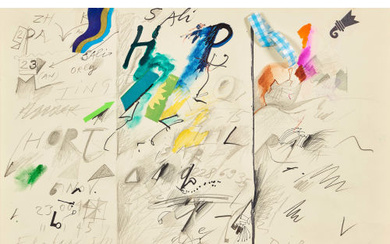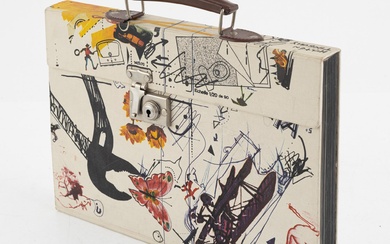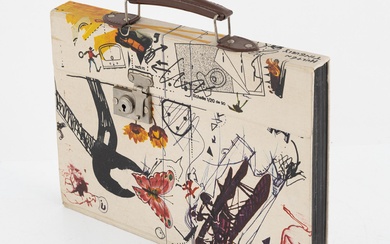JEAN TINGUELY (Switzerland, 1925 -1991). Untitled, 1972. Mixed media on paper. Signed, dated and
JEAN TINGUELY (Switzerland, 1925 -1991).
Untitled, 1972.
Mixed media on paper.
Signed, dated and inscribed.
Stains on the passepartout and in the margins of the work.
Size: 35 x 25 cm; 48 x 37,5 cm (frame).
If anything characterises Jean Tinguely's work on paper, it is movement, chance and the use of everyday materials intuitively dispersed on its surface. Throughout his career as an artist, Jean Tinguely sent hundreds of illustrated messages to his friends and colleagues in the art world. All these missives had one thing in common: they were written wherever the artist was - in his studio, in a museum or a gallery, in his kitchen, in a restaurant or even on the floor of his home. They had all been created in a totally intuitive way, driven by the subconscious and regardless of the place or time of their creation. Tinguley himself nodded: "I draw a lot of things, just as I doodle while talking on the phone. At the same time, I systematically transform these kinds of drawings into messages to my friends, letters and things like that.
The Swiss painter and sculptor was, for more than 30 years, a key figure in the European avant-garde movement. He was known for his "sculpture machines" or kinetic art, rooted in the Dada tradition. He applied the term meta-mechanics to his creations. As in the rest of his kinetic works, his purpose was to give the spectator a spectacle of displacement, or at least the illusion of it. Jean Tinguely's mobile works were created to destroy or self-destruct, all in an effort to satirise the overproduction of meaningless goods manufactured by advanced industrial society. After turning to abstract painting, the Swiss artist experimented with movement as a form of expression. His first works, exhibited in Paris, were moved by electric motors. These monumental pieces depicted an ironic universe of useless machines that, it seemed, were producing. "The concept is to show that a work of art is never a definitive object, but that its creative capacities are, in truth, the potential given to it by both the artist and the spectators. He also worked on ready-made works, approaching the New York New Realists and assemblage artists. His production, which touched on all the themes that interested the artists of his generation, earned him an important place in post-war Paris, a leading figure of the stature of Yves Klein. Jean Tinguely is currently represented in the most important museums all over the world, including the Tinguely Museum in Basel, Switzerland, dedicated to the painter's life and work, the Tate Modern in London, the Metropolitan Museum of Art in New York and the Museo Reina Sofà a.
Estimate
Reserve
Time, Location
Auction House
JEAN TINGUELY (Switzerland, 1925 -1991).
Untitled, 1972.
Mixed media on paper.
Signed, dated and inscribed.
Stains on the passepartout and in the margins of the work.
Size: 35 x 25 cm; 48 x 37,5 cm (frame).
If anything characterises Jean Tinguely's work on paper, it is movement, chance and the use of everyday materials intuitively dispersed on its surface. Throughout his career as an artist, Jean Tinguely sent hundreds of illustrated messages to his friends and colleagues in the art world. All these missives had one thing in common: they were written wherever the artist was - in his studio, in a museum or a gallery, in his kitchen, in a restaurant or even on the floor of his home. They had all been created in a totally intuitive way, driven by the subconscious and regardless of the place or time of their creation. Tinguley himself nodded: "I draw a lot of things, just as I doodle while talking on the phone. At the same time, I systematically transform these kinds of drawings into messages to my friends, letters and things like that.
The Swiss painter and sculptor was, for more than 30 years, a key figure in the European avant-garde movement. He was known for his "sculpture machines" or kinetic art, rooted in the Dada tradition. He applied the term meta-mechanics to his creations. As in the rest of his kinetic works, his purpose was to give the spectator a spectacle of displacement, or at least the illusion of it. Jean Tinguely's mobile works were created to destroy or self-destruct, all in an effort to satirise the overproduction of meaningless goods manufactured by advanced industrial society. After turning to abstract painting, the Swiss artist experimented with movement as a form of expression. His first works, exhibited in Paris, were moved by electric motors. These monumental pieces depicted an ironic universe of useless machines that, it seemed, were producing. "The concept is to show that a work of art is never a definitive object, but that its creative capacities are, in truth, the potential given to it by both the artist and the spectators. He also worked on ready-made works, approaching the New York New Realists and assemblage artists. His production, which touched on all the themes that interested the artists of his generation, earned him an important place in post-war Paris, a leading figure of the stature of Yves Klein. Jean Tinguely is currently represented in the most important museums all over the world, including the Tinguely Museum in Basel, Switzerland, dedicated to the painter's life and work, the Tate Modern in London, the Metropolitan Museum of Art in New York and the Museo Reina Sofà a.







